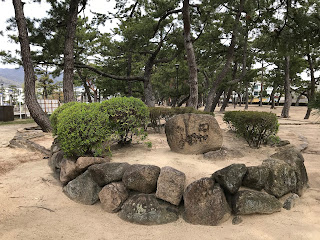Associated with: Nue aka "the Japanese chimera"
Your humble driver Gragma has been busy driving his tour bus, Boils and Ghouls, so it's been a few weeks between posts. Did you miss me? I know you did! The site managed to average one hit every few days. You really do love me!
No time for that mush now though. I believe we have the matter of a floating animal carcass to attend to. In the last entry, we saw the good people of Osaka behaving in a most charitable way toward the dead nue, giving it a proper burial and praying for its tormented soul. But in another telling, our dear Osakans are less sympathetic and shove the craft back into the river. Some things require another flush to make them gone for good.
This second launching saw the nue drift through the heart of Osaka and out into the bay. The nue then beached itself in a town called Ashiya at the mouth of a river of the same name. Though I find it difficult to picture the current residents of Ashiya (now an upmarket residential area) going out of their way to bury the rotting body of a dead animal, perhaps it was the smell of the well-and-truly ripe nue that convinced them to, if not give the poor thing a burial, then at least bury the poor thing. Their nue mound, or nuezuka (鵺塚), is there to this day in Ashiya Park.
Map courtesy of Google Maps
Notice something weird about the location? I had assumed that all rivers flow into the sea, where here it appears that the nue floated into the river and deposited itself about a quarter mile upstream. Let's zoom out a bit.
Map courtesy of Google Maps
Hmm, not the most natural looking of coastlines, is it? By the way, where you can see "Osaka Aquarium Kaiyukan" in the corner of the map is approximately where the nue floated out into Osaka Bay. Okay, well what if we were to do a google search for "Hama-Ashiya-cho" ("Ashiya-on-the-Beach), the municipal designation the mound is located in.
Map courtesy of Google Maps
Ashiya-on-the-Beach seems to deliver only half of what it promises... unless of course what we're looking at was initially much closer to the original coastline. Ah. Mystery solved as to how our carcass managed to make its way "upstream." Let's take a look at a map from around 1700 as a comparison.
Map courtesy of Google Maps / National Archives of Japan
Comments: Get on your fancy pants because we're going to Ashiya! Why would we want to do that? Haruki Murakami grew up in the area... and apparently it's the only municipal designation in all of Japan that prohibits pachinko parlors, entertainment facilities and factories. That means you'll either love it or be bored to death. Ashiya!
Getting There
The starting point on the Midosuji subway line is Umeda Stn. Our destination is Ashiya Stn. on the Hanshin Line.
Subway Umeda Stn. lies next to other stations, also called Umeda, operated by two train companies: Hankyu and Hanshin. From subway Umeda Stn. (or Osaka Stn. if you've come via JR), follow the signs directing you to the Hanshin Line. There are two lines that leave from Hanshin Umeda, and Ashiya is on the Hanshin Main Line. From Umeda, you can jump on just about anything to get to Ashiya, but two services, the "Express" and the "Morning Express" will terminate a few stations before it. Any kind of limited express service will get you there in about 20 minutes. Ashiya is 19 stops on the local, so it's worth your time to wait for a limited express.
Getting Your Bearings at Ashiya Station
Getting from the station to the nuezuka is not difficult at all, though the grave itself is rather nondescript and you need to be careful not to walk past it. Basically all you do is follow a straight line south from the station. If you're coming from Osaka you'll be traveling west toward Kobe, so south is on your left as you're pulling into the station with the mountainous north on your right.
By far the easiest thing to do is follow the Ashiya River down a few blocks to Ashiya Park, and the mound is located on the southwest corner of the park at a set of traffic lights. If you start passing some tennis courts it means you've gone too far.
Map courtesy of Google Maps
The route above takes you along the west bank of the river and then back over a bridge adjacent to the mound. This bridge is the Nuezukabashi (鵺塚橋), or Nuezuka Bridge (lit. Nue Mound Bridge). As far as I know, the bridge bears no significance other than its proximity to the mound.
Photo Credit: Gragma's Yokai Tourbus
The first major landmark you'll come to is the Hanshin Expressway, which you'll need to navigate past yourself. The easiest way to do this is by taking some steps down onto the riverbank and walking under. These appear intermittently along the road. Not long after the expressway you'll come to the Nuezuka Bridge.
Map courtesy of Google Maps
Photo Credit: Gragma's Yokai Tourbus
Once you're over the bridge, cross the road and the mound is on the corner. There is a white placard marking the spot, which is circled in the first shot below.
Image courtesy of Google Maps
Photo Credit: Gragma's Yokai Tourbus
It doesn't look like much but there you have it. If you're super keen, you can follow the river a bit futher south to where the Ashiya River now meets the sea. Um, it ain't that great though.
Driver Gragma (yokaitourbus "at" mail "dot" com)
Facebook: https://www.facebook.com/yokaitourbus/
The Master List (Hyogo):
http://yokaitourbus.blogspot.jp/2015/08/6-b-master-list-hyogo.html
(yokai) Nue (鵺)
Site: Grave of the Nue, or Nuezuka (鵺塚) in Ashiya
Nearest Station: (Hanshin Line) Ashiya Stn. (芦屋駅)
Google Map Search: NA










No comments:
Post a Comment